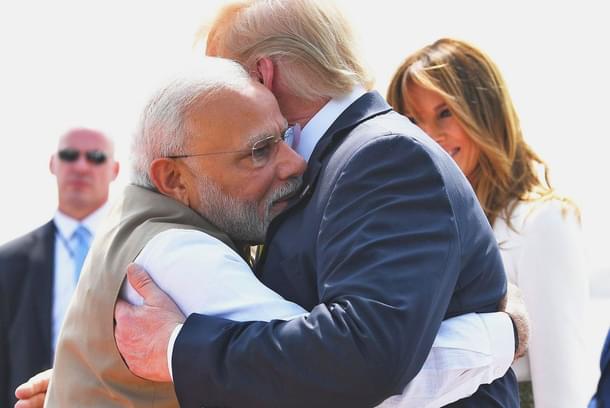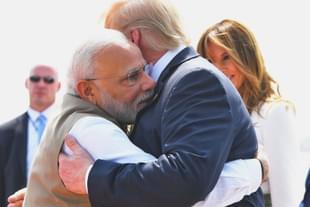World
Should India Be Wary Of Uncle Sam’s Fickle Embrace? The Evidence Proves Otherwise
R Jagannathan
Feb 25, 2020, 03:05 PM | Updated 07:17 PM IST
Save & read from anywhere!
Bookmark stories for easy access on any device or the Swarajya app.


Henry Kissinger, US Secretary of State and National Security Advisor to Presidents Richard Nixon and Gerald Ford, once said that it was dangerous to have the US as an enemy, but fatal to have it as a friend.
Given the number of former allies who were ditched by the US when the superpower’s geopolitical priorities changed, this statement has more than an element of truth in it.
From South Vietnam to various Latin American countries to Iran, Egypt, Iraq and Afghanistan (coming up soon once a deal with the Taliban can be arranged), no country which allowed itself to be embraced by America can claim to have had a loyal friend.
So, how should Narendra Modi view the warm embrace by Donald Trump at Motera Stadium yesterday (24 February), where both leaders swore great and lasting friendship? Will Kissinger’s statement come true for India too?
The answer is a qualified no. Unlike some of the smaller allies whom the US abandoned when the going got tough, India has the ability to stand on its own feet even if given the cold shoulder by Uncle Sam.
From Nixon’s Pakistan tilt during the Bangladesh war, to Bill Clinton’s sanctions after the Pokharan-II nuclear tests, to George Bush’s decision to deny Narendra Modi a visa, to Donald Trump’s own bid to coerce India to abandon its Russian military ties and open up the Indian markets to American companies, India has withstood all of US pressures and still remained a reasonable partner.
The Kissinger statement seems to have an exception in India, possibly due to the size and scale of India’s economy and its geopolitical role as a counterweight to China.
Under Nixon and Kissinger, the US tilted formally in favour of Pakistan in 1971, but could do nothing to prevent the slicing of Bangladesh into a separate country.
Under Clinton, the US launched wide-ranging economic and military sanctions against India, but Atal Behari Vajpayee’s government stood firm and reformed the economy, making it impossible for the US to continue treating India like a pariah.
Relations improved under Clinton and then again under George W Bush. After Narendra Modi’s victory in 2014, President Barack Obama could have piled on the pressure and not issued him a visa, but he saw no gain in doing so despite the activities of the evangelical lobby.
Modi went to America and got Obama over to India twice during his first tenure. The hand that denied the visa was unable to continue doing so once the people of India had spoken in favour of Modi.
India’s political class — both Congress and BJP — and its diplomats have learnt to live with the fickle nature of American politics. While India’s romance with the US has gone from cold to hot to lukewarm and then hot and cold again in many cycles, we have now understood the real factors that influence America’s policy flip flops.
They result from its peculiar geography and domestic politics.
First, as a country insulated from any military threats to itself due to its continental status with two oceans dividing it from the rest of the world, America has a schizophrenic foreign policy, sometimes driven by isolationism, and sometimes by global involvement when that looks attractive.
Both in terms of economic size and military clout, America does not need the world as much as the world needs America.
In both the world wars of the last century, America entered the picture only at a late stage, when its resources could be decisive in winning the war. On the other hand, whenever it entered wars in faraway places driven by pure hubris or the need to avenge American humiliation (in Vietnam, Iraq and Afghanistan, for example), it has always come a cropper.
It then shrinks back to its state of splendid isolation, as it is now doing under Donald Trump.
This is the main reason why smaller allies can’t count on the Americans to stick by them forever, for friendship is as fickle as the weather.
But countries like India, which can survive without America whenever it turns unfriendly, have the ability to accept Uncle Sam’s handshake whenever he is in a good mood.
As again is the case under Trump. We know this may not last forever, but why not benefit from a passing embrace?
The second schizophrenia that drives American policy is the Right-Left divide, which has grown sharper over the last few decades. When the Right is in power, usually under a Republican administration, evangelical groups start popping up.
India tends to be a particular target since it is the largest market for religious conversion and sensitive to bullying by narrow-minded busybodies like the USCIRF, the US Commission for International Religious Freedom.
It was under a Republican administration that Modi’s US visa got withheld.
On the other hand, whenever Democrats have been in power, we hear lectures on human rights, and the State Department, which is run by cold war hawks who preferred Pakistan to India, starts acting up.
If Bernie Sanders comes to power in 2021 as US President, we can expect US pressure on Kashmir and Article 370 to grow substantially.
This explains why Narendra Modi went the farthest among all Indian Prime Ministers to nearly endorse a sitting US President like Trump.
India-US relations, despite Trump’s pressure on trade and military ties, have remained on an even keel because he is neither too evangelical in his leanings nor a holier-than-thou human rights crusader.
He is transactional, and India knows that.
This is what explains the current US-India bonhomie. If a Bernie Sanders becomes President and turns on the heat, India will still overcome. Kissinger’s thesis does not work when it comes to India.
Jagannathan is former Editorial Director, Swarajya. He tweets at @TheJaggi.





